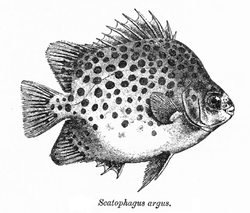Scatophagus
Scatophagus is a fish genus in the family Scatophagidae. Species in this genus are referred as spotted scats.
| Scatophagus | |
|---|---|
 | |
| (Scatophagus argus) | |
| Scientific classification | |
| Kingdom: | |
| Phylum: | |
| Class: | |
| Order: | |
| Family: | |
| Genus: | Scatophagus |
| species | |
|
See text for species. | |
| Synonyms | |
|
Cacodoxus Cantor, 1849 | |
They are small fish native to the Indian and western Pacific Oceans that have been popular in the aquarium trade in the last 30 years. Although juvenile scats may live in a freshwater environment, most adult scats prefer a brackish water environment. However, the African scat, Scatophagus tetracanthus, can and does live in fresh water in the wild. The largest species reaches 38 cm in length and some have been known to live more than 20 years in captivity given the proper water conditions. They are scavengers, feeding on algae and feces, hence their name, from Greek skatos meaning "feces" and phagein meaning "eat".
Species
- S. argus – common scat, green scat, ruby scat
- S. tetracanthus – African scat (Lacépède, 1802).
Extinct species
The fossil Eoscatophagus frontalis Tyler & Sorbini, 1999[1] (syn. Scatophagus frontalis Agassiz, 1839) is from the Middle Eocene of the North Italian Monte Bolca formation that originated from sediments of the Tethys.[2][3]
References
- Tyler, J.C. & Sorbini, C. 1999. Phylogeny of the fossil and recent genera of fishes of the family Scatophagidae (Squamipinnes). Boll. Mus. Civ. Stor. Nat. Verona 23
- pages 353–393
- L. Agassiz. 1842. Recherches Sur Les Poissons Fossiles. Tome IV (livr. 14). Imprimerie de Petitpierre, Neuchâtel 205-291 (French)
- Karl Albert Frickhinger: Fossilien Atlas Fische, Mergus-Verlag, Melle, 1999, ISBN 3-88244-018-X
External links
- "Scatophagus". Integrated Taxonomic Information System. Retrieved 23 August 2015.

- Parenti, Paolo (February 2004). "Family Scatophagidae Bleeker 1876" (PDF). Annotated Checklists of Fishes (36). ISSN 1545-150X.